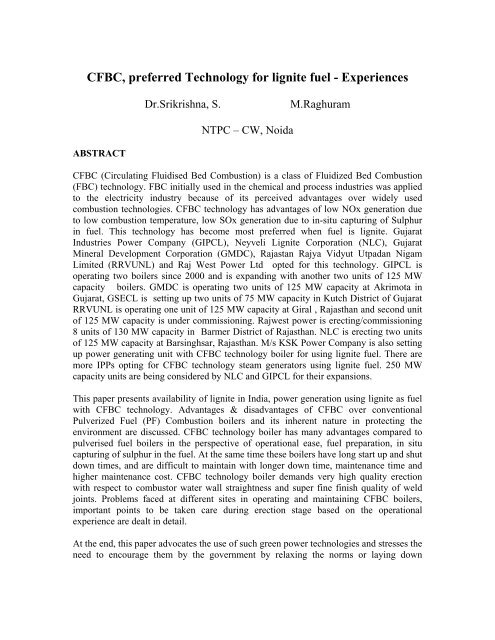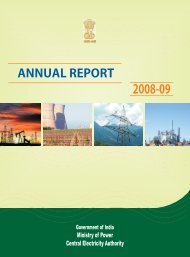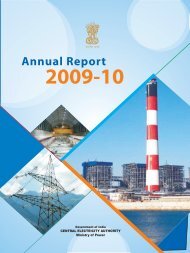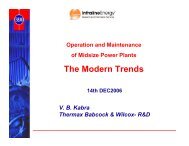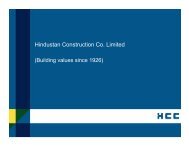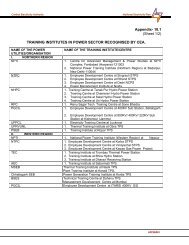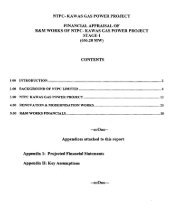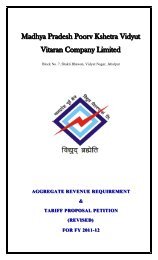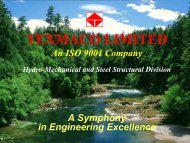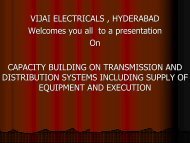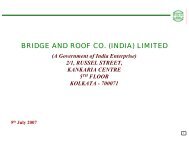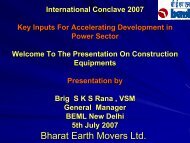CFBC, preferred Technology for lignite fuel - Experiences - Infraline
CFBC, preferred Technology for lignite fuel - Experiences - Infraline
CFBC, preferred Technology for lignite fuel - Experiences - Infraline
Create successful ePaper yourself
Turn your PDF publications into a flip-book with our unique Google optimized e-Paper software.
<strong>CFBC</strong>, <strong>preferred</strong> <strong>Technology</strong> <strong>for</strong> <strong>lignite</strong> <strong>fuel</strong> - <strong>Experiences</strong><br />
Dr.Srikrishna, S.<br />
M.Raghuram<br />
NTPC – CW, Noida<br />
ABSTRACT<br />
<strong>CFBC</strong> (Circulating Fluidised Bed Combustion) is a class of Fluidized Bed Combustion<br />
(FBC) technology. FBC initially used in the chemical and process industries was applied<br />
to the electricity industry because of its perceived advantages over widely used<br />
combustion technologies. <strong>CFBC</strong> technology has advantages of low NOx generation due<br />
to low combustion temperature, low SOx generation due to in-situ capturing of Sulphur<br />
in <strong>fuel</strong>. This technology has become most <strong>preferred</strong> when <strong>fuel</strong> is <strong>lignite</strong>. Gujarat<br />
Industries Power Company (GIPCL), Neyveli Lignite Corporation (NLC), Gujarat<br />
Mineral Development Corporation (GMDC), Rajastan Rajya Vidyut Utpadan Nigam<br />
Limited (RRVUNL) and Raj West Power Ltd opted <strong>for</strong> this technology. GIPCL is<br />
operating two boilers since 2000 and is expanding with another two units of 125 MW<br />
capacity boilers. GMDC is operating two units of 125 MW capacity at Akrimota in<br />
Gujarat, GSECL is setting up two units of 75 MW capacity in Kutch District of Gujarat<br />
RRVUNL is operating one unit of 125 MW capacity at Giral , Rajasthan and second unit<br />
of 125 MW capacity is under commissioning. Rajwest power is erecting/commissioning<br />
8 units of 130 MW capacity in Barmer District of Rajasthan. NLC is erecting two units<br />
of 125 MW capacity at Barsinghsar, Rajasthan. M/s KSK Power Company is also setting<br />
up power generating unit with <strong>CFBC</strong> technology boiler <strong>for</strong> using <strong>lignite</strong> <strong>fuel</strong>. There are<br />
more IPPs opting <strong>for</strong> <strong>CFBC</strong> technology steam generators using <strong>lignite</strong> <strong>fuel</strong>. 250 MW<br />
capacity units are being considered by NLC and GIPCL <strong>for</strong> their expansions.<br />
This paper presents availability of <strong>lignite</strong> in India, power generation using <strong>lignite</strong> as <strong>fuel</strong><br />
with <strong>CFBC</strong> technology. Advantages & disadvantages of <strong>CFBC</strong> over conventional<br />
Pulverized Fuel (PF) Combustion boilers and its inherent nature in protecting the<br />
environment are discussed. <strong>CFBC</strong> technology boiler has many advantages compared to<br />
pulverised <strong>fuel</strong> boilers in the perspective of operational ease, <strong>fuel</strong> preparation, in situ<br />
capturing of sulphur in the <strong>fuel</strong>. At the same time these boilers have long start up and shut<br />
down times, and are difficult to maintain with longer down time, maintenance time and<br />
higher maintenance cost. <strong>CFBC</strong> technology boiler demands very high quality erection<br />
with respect to combustor water wall straightness and super fine finish quality of weld<br />
joints. Problems faced at different sites in operating and maintaining <strong>CFBC</strong> boilers,<br />
important points to be taken care during erection stage based on the operational<br />
experience are dealt in detail.<br />
At the end, this paper advocates the use of such green power technologies and stresses the<br />
need to encourage them by the government by relaxing the norms or laying down
separate norms in respect of Auxiliary Power Consumption, reimbursement of complete<br />
<strong>fuel</strong> additive charges, if necessary.<br />
Introduction<br />
India has total estimated usable <strong>lignite</strong> reserves of 97,000 MMT , concentrated in the<br />
states of Tamilnadu, Gujarat and Rajasthan. Tamilnadu has 70,000 million Tones,<br />
Rajasthan has15,000 million Tones, Gujarat has 12,000 million Tones. All these states<br />
are far away from coal reserves located in India. It is economical to use <strong>lignite</strong> <strong>for</strong> power<br />
generation in these areas. These are more than 30% of coal reserves available in India.<br />
Estimated power generation capacity addition with this <strong>lignite</strong> reserves is around<br />
3,00,000 MW <strong>for</strong> 50 years. India has not exploited <strong>lignite</strong> reserves available <strong>for</strong> power<br />
generation as it has to be considering the available resources. Per<strong>for</strong>mance of units with<br />
PF technology using <strong>lignite</strong> has been low. Per<strong>for</strong>mance of Units with <strong>CFBC</strong><br />
technology using <strong>lignite</strong> is encouraging.<br />
<strong>CFBC</strong> operates with combustor temperatures in the region of 850 – 900 deg C. These<br />
combustor temperatures are much lower than ash fusion temperature. So, in <strong>CFBC</strong><br />
boilers problem of any clinker <strong>for</strong>mation is not encountered with <strong>lignite</strong> as primary <strong>fuel</strong>.<br />
General quality of <strong>lignite</strong> <strong>fuel</strong> available <strong>for</strong> using in boilers in India is as follows:<br />
Parameter Range<br />
Total Moisture 40 to 52%<br />
Ash 8 to 20 %<br />
VM 21 to 34%<br />
FC 11 to 20 %<br />
CV<br />
2500 to 4000 Kcal/kg<br />
Sulphur 1 % to 6%<br />
Chloride 0.20 % to .35%<br />
ADVANTAGES OF <strong>CFBC</strong> TECHNOLOGY<br />
Environment Friendly<br />
Sulfur emissions are effectively controlled by adding lime stone to the fluidized bed,<br />
eliminating the need <strong>for</strong> an external desulfurization process such as SO2 scrubbers,<br />
which are costly. Because of reduced combustion temperatures, Nox emissions are<br />
inherently low or negligible.<br />
Fuel Flexibility<br />
FBC units were touted as being “<strong>fuel</strong> flexible”, with the capability of firing a wide<br />
range of solid <strong>fuel</strong>s with varying heating value, ash content, and moisture content.<br />
Combustion in FBC units takes place at temperatures below the ash fusion<br />
temperatures of most <strong>fuel</strong>s. Consequently, tendencies <strong>for</strong> slagging and fouling are<br />
greatly reduced with FBC.
Simplified Fuel Preparation And Feeding<br />
Normally crushers are sufficient <strong>for</strong> <strong>fuel</strong> preparation. A top size, in the range of 5 –<br />
12 mm is required <strong>for</strong> sub-bituminous coals. Pulverizes and associated maintenance<br />
are eliminated.<br />
Compact Plant Design<br />
<strong>CFBC</strong> boilers require less floor space than conventional steam generators with down<br />
stream flue gas cleaning equipment.<br />
Sustainability Under Cyclic Loading<br />
Minimizes stress on boiler tube material with low variation of combustor<br />
temperatures under cyclic loading of boiler particularly under varying grid<br />
frequencies.<br />
High Reliability<br />
Low flue gas velocities in combustor minimizes erosion and hence the boiler tube<br />
failures leading to very high reliability of the boiler.<br />
Comparison of <strong>CFBC</strong> technology with PF technology on some parameters<br />
Description CFB Boiler PF Boiler Benefits of CFB<br />
Fuel Size 12-6 mm >70%
<strong>CFBC</strong> boiler is operational friendly. This boiler is called dark boiler because of<br />
absence of any flame in the combustor. Hence, there is no boiler tripping due to flame<br />
failure/ furnace disturbance. As this boiler has huge refractory and very large amount<br />
of bed ash in circulation, there is no need to trip the turbine in case of all <strong>fuel</strong> cut off<br />
to boiler <strong>for</strong> about 20 minutes. Boiler continues generating steam within specified<br />
parameters <strong>for</strong> sustaining turbine at reduced loads. <strong>CFBC</strong> combustor is a reservoir of<br />
heat energy. This energy is used in case of all <strong>fuel</strong> failure <strong>for</strong> short duration be<strong>for</strong>e<br />
restoration of one of the <strong>fuel</strong> available (<strong>lignite</strong> or oil). <strong>CFBC</strong> boilers do not<br />
experience large sharp fluctuations in boiler pressure due to very stable firing system.<br />
Oil support is not required even at part loads of about 25 % and combustor<br />
temperatures, steam parameters are maintained. <strong>CFBC</strong> boilers have almost zero<br />
combustibles in bottom ash with share of bottom ash of about 30-40%. The intense<br />
heat storage capacity of this boiler makes it useful <strong>for</strong> quick hot re-starts.<br />
One of the disadvantages of <strong>CFBC</strong> boiler is longer cold start-up and shut down time.<br />
Cold start-up time is about 10-12 hours as boiler is to be heated up slowly at specified<br />
heating rates as per refractory heat up curves. Similarly during shutdown also, gradual<br />
cooling is required. A typical boiler start-up is given Fig: 1. As lime is added in<br />
<strong>CFBC</strong> boiler <strong>for</strong> capturing Sulfur, the units with <strong>CFBC</strong> boilers have more number of<br />
auxiliary equipments such as air blowers, limestone handling, milling and<br />
transporting system. Hence, auxiliary power consumption is on higher side <strong>for</strong> lower<br />
capacity units.<br />
Figure-1: Typical Boiler start-up curve from light-up to Synchronization of Unit<br />
700<br />
600<br />
Temperature in deg C<br />
500<br />
400<br />
300<br />
200<br />
100<br />
0<br />
30 60 90 120 150 180 210 240 270 300 330 360 390 420 450 480 510 540 570 600<br />
Time in Minutes<br />
Lower bed Temp Middle bed Temp FG temp after Cyclone FG temp after Economiser FG temp after APH<br />
Using Lignite as <strong>fuel</strong> with <strong>CFBC</strong> boilers, following environmental parameters can be achieved.<br />
SOx (ppm) NOx (ppm) CO (mg/N.Cu.M) SPM(mg/N.Cu.M)<br />
< 50 < 20
Other General operation problems being experienced are:<br />
• Back sifting of bed ash in to primary air wind box trough combustor nozzle<br />
grate<br />
• Pulsation in cyclones at lower loads, bed ash/bed materials hang up in<br />
cyclones.<br />
• Agglomeration of ash in combustor to cyclone ducts.<br />
• Deposition of ash on back-pass coils.<br />
• Clinker <strong>for</strong>mation in Start up burners ,Bed lances<br />
Maintenance <strong>Experiences</strong>:<br />
<strong>CFBC</strong> boilers experience higher erosion rates in water wall tubes at refractory<br />
transition zone in general. <strong>CFBC</strong> combustor has refractory lining up to about 9 meters<br />
height to protect water wall against erosion. But erosion problems experienced at<br />
refractory transition zone due to bed material sliding back to combustor along water<br />
wall from different heights. Erosion of water wall at this zone is due to scooping<br />
action of bed material. Some designs use kick-out tubes to overcome this problem.<br />
To protect the water wall tube from erosion, protective coating is being used in some<br />
units and is giving satisfactory results. Area requiring metal spray can be identified<br />
with the help of tube thickness survey of water wall and identifying erosion pattern.<br />
Life of water wall tubes in these areas extended to three times with metal spray.<br />
Due to large quantities of refractory and bed ash in circulation, <strong>CFBC</strong> boilers require<br />
more down time to repair as it takes longer periods to cool down boiler to working<br />
temperature. A typical cooling curve is shown Fig 2. This is results in increased down<br />
time and decreased availability. These boilers also demand major refractory repairs<br />
particularly in combustor water wall refractory, ash cooler refractory and refractory<br />
along <strong>fuel</strong> path.<br />
In case a tube leakage in combustor or Fluidized bed Heat Exchangers (FBHE) in<br />
some designs requires immediate evacuation of all bed material to avoid solidification<br />
of the material (due to presence of Calcium sulfate).<br />
Non Metallic expansion Joints (NMEJs) in ash cycle path also require very special<br />
attention. Any ingress of hot bed material in to it will damage the NMEJ.<br />
Combustor grate nozzle is another major maintenance area. Severe erosion is<br />
observed in the nozzles due to bed material. About 10% of nozzles require<br />
replacement every year.<br />
Lignite chain feeders, Bead ash handling equipment also require more maintenance<br />
due to corrosion and erosion.
As <strong>lignite</strong> has high sulfur content, in absence of proper Sulfur capture, chances of<br />
cold end corrosion in tubular Air Pre-heater are more and may require frequent<br />
replacement of entire cold banks. Presence of chlorides in <strong>lignite</strong> will further<br />
aggravate the problem.<br />
Figure-2: Cooling curve of <strong>CFBC</strong> Boiler at SLPP<br />
1000<br />
900<br />
800<br />
700<br />
Furnace Bottom Temp<br />
600<br />
500<br />
400<br />
300<br />
200<br />
100<br />
0<br />
1 4 7 101316192225283134374043464952555861646770737679828588919497<br />
Time in Hrs<br />
Max<br />
Min<br />
CONCLUSIONS<br />
For a developing nation planning to meet the rising demand with capacity additions, use<br />
of technologies, which are environmental friendly and minimize the impact on<br />
environment, is necessary. <strong>CFBC</strong> is one of such Technologies that operates under low<br />
combustion temperatures and has facility to add sorbent. It effectively minimizes the Sox<br />
and NOx emissions. It can also use poor quality <strong>fuel</strong>s <strong>for</strong> effective, efficient combustion<br />
minimizing emissions and impact on environment. Advantages of <strong>CFBC</strong> technology,<br />
special commissioning activities of this environmental friendly technology, experiences<br />
have been briefly discussed. Several power generating companies have adopted this<br />
technology. Problems experienced by power generators using <strong>CFBC</strong> technology have<br />
been presented along with special care to be taken during erection stage. To encourage<br />
the adoption of such environment friendly technology, government or the beneficiary<br />
should help the generating companies by relaxing the normative operating/commercial<br />
norms such as Auxiliary power consumption and reimbursement of cost of <strong>fuel</strong> additive.
India has good reserves of <strong>lignite</strong> in Gujarat, Rajastan & Tamilnadu parts of the country.<br />
This has already been in use <strong>for</strong> power generation. But using <strong>lignite</strong> in conventional PF<br />
boilers has several problems of clinkering. <strong>CFBC</strong> is most suitable technology <strong>for</strong> <strong>lignite</strong><br />
<strong>fuel</strong> as has been experienced by power generating companies. Important thing that has to<br />
be taken care is improvisation of this technology <strong>for</strong> Indian working conditions. Some of<br />
the elements of this technology may need to be developed <strong>for</strong> suiting Indian conditions.<br />
NTPC may also plan <strong>for</strong> adopting this technology <strong>for</strong> coal with higher sulphur or <strong>lignite</strong>.


